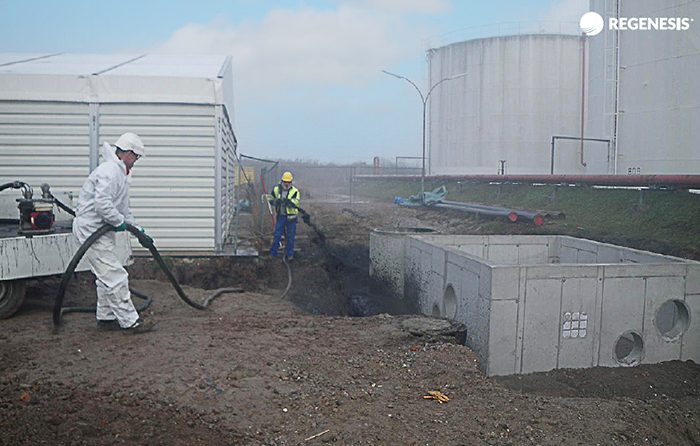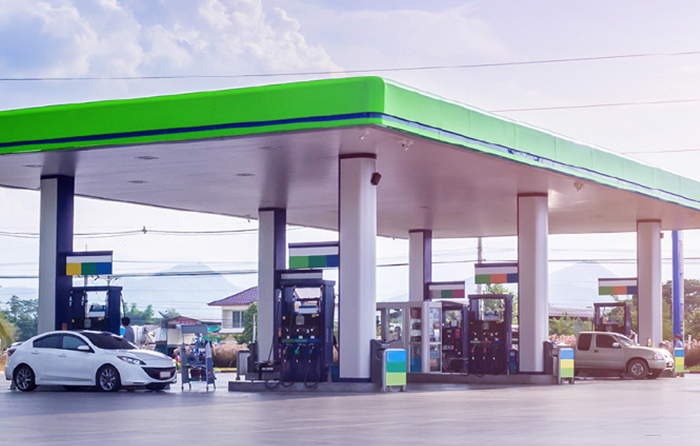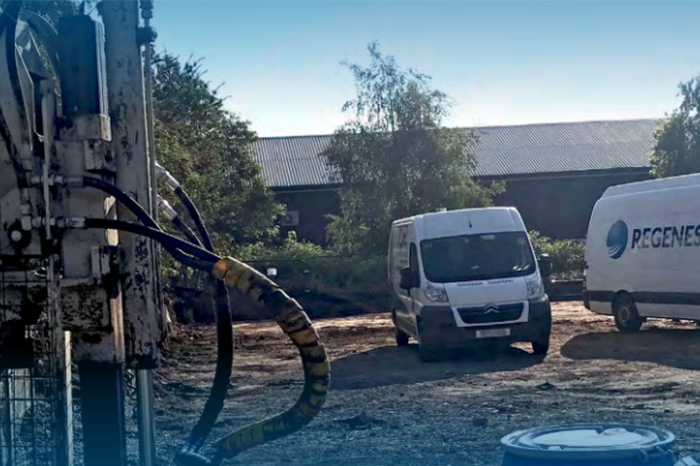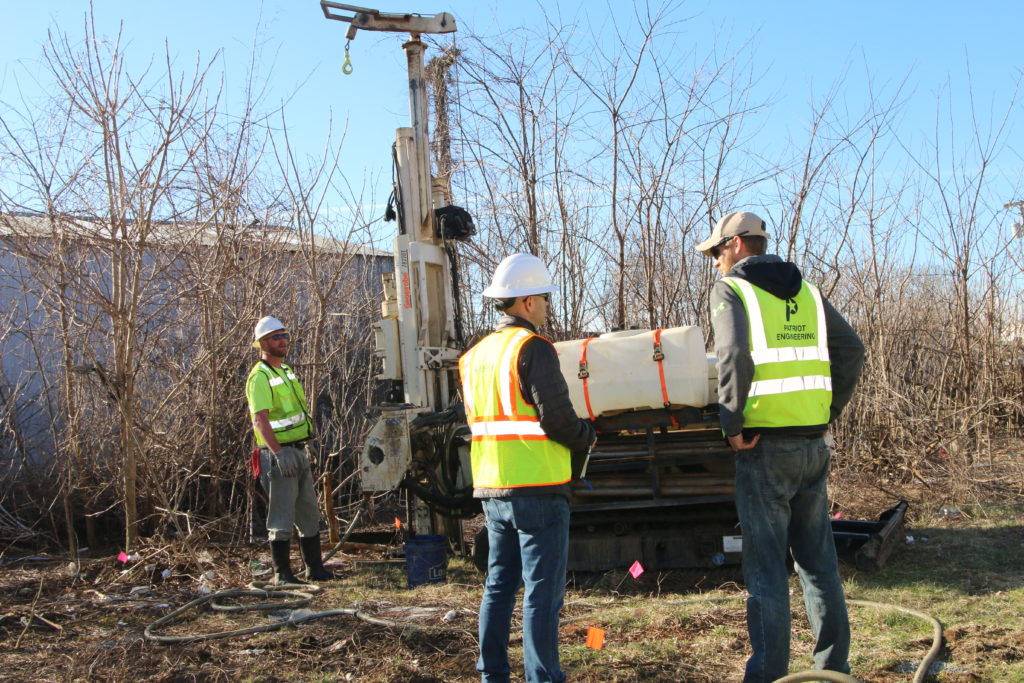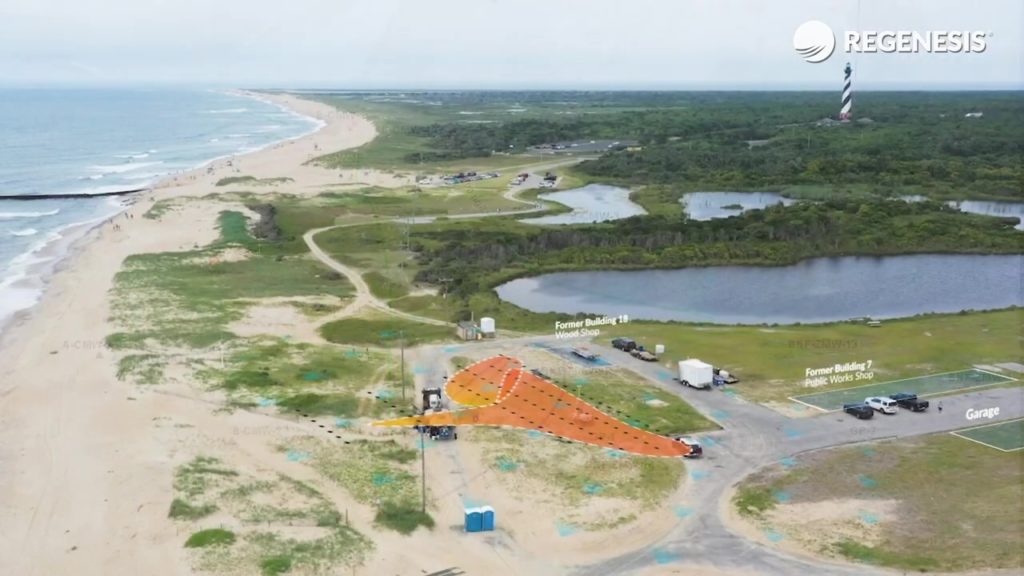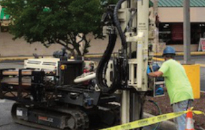PetroFix Provides Preventative Treatment for Pipeline Installation
Case study highlights:
- PetroFix prevents recurring contamination
- PetroFix application allows installation of new pipeline
- Spray application of PetroFix onto walls and floor of pipeline corridor post-excavation
This case study reviews a new underground pipeline that was to be installed across a complex chemical plant in southwestern Germany. It was found that part of the pipeline would intersect an area of soil and groundwater impacted with petroleum hydrocarbons and BTEX compounds. The impacted soils and groundwater in the immediate vicinity of the piperun would be removed through excavation and dewatering. However, residual contamination would be left in place beside and below adjacent existing structures, where excavation could not be progressed for structural/geotechnical reasons. The residual contamination in these soils represented an ongoing secondary source of contamination, which could diffuse and desorb into the groundwater and re-contaminate the excavated area. This could result in contamination of the clean backfill around the pipeline, plus the granular pipe-bedding material would provide a conduit through which re-contaminated groundwater could spread further across and potentially beyond the site.
No Further Action Achieved at Gas Station Site
Case study highlights:
- Collaboration between PPM Consultants and REGENESIS resulted in substantial cost savings while achieving the no further action goal
- REGENESIS Remediation Services implemented a highly-controlled injection program
- Following the application and subsequent monitoring, the treatment objective was met
This case study reviews a gasoline service station near the Mississippi River in central-eastern Louisiana that was contaminated with petroleum hydrocarbons (PHCs) detected in soil and groundwater. Further investigation phases were performed to define the magnitude and extent of the PHC plume, confined to predominantly fine-grained soils (i.e., silt and clay) in the upper 15 feet below ground surface (bgs). In 2015, PPM Consultants, Inc. (PPM) submitted a Corrective Action Plan (CAP) to the Louisiana Department of Environmental Quality (LDEQ) to remediate benzene (i.e., the primary PHC of concern), in soil and groundwater. In the CAP, PPM proposed an in situ chemical oxidation (ISCO) and aerobic bioremediation treatment approach utilizing PersulfOx® and ORC Advanced®. The ISCO to bio treatment approach was nearly 50% more cost-effective than the installation of either dual-phase extraction or ozone sparging systems, two possible approaches considered by PPM prior to determining the final remedy.
PetroFix in situ PRB replaces cut-off wall design to benefit redevelopment project
Case study highlights:
- 40m long in situ barrier installation completed within 5 days
- Small working footprint – no disruption to construction works
- This alternative solution provides immediate and long-term groundwater treatment
- GE Awards 2020 winner: The judges commented on the innovative method and recognised the reduced programme and significantly reduced quantities of soil sent to landfill, minimising environmental impact
At the site of a former storage and distribution depot in Coventry, the soils and groundwater were impacted with petroleum hydrocarbons from previous site usage, which included a petrol filling station that had been located just north of the site and also across part of the site itself. Cundall created a multi-phased remediation strategy with Alto Construct to deal with the soils and asked REGENESIS to carry out the groundwater remediation. REGENESIS installed a PetroFix activated carbon permeable reactive barrier at the edge of the site to capture and promote the biological degradation of high levels of dissolved phase contamination migrating on-site, to protect the redevelopment site as well as the adjacent river.
A Fuel Spill Caused by a Truck Rollover in Montana Receives No Further Action Following PetroFix Application
Case study highlights:
- No further action received
- Potential impacts to scenic river eliminated
- 2400 pounds of PetroFix applied to fuel spill excavation
This case study reviews a semi-truck that was hauling gasoline and diesel and overturned into a dry irrigation ditch in Montana. The diesel tanks ruptured and released fuel into the ditch, impacting the shallow water table with petroleum hydrocarbons (PHCs), including benzene, toluene, ethylbenzene, and xylenes (BTEX). The irrigation ditch feeds a larger irrigation canal that empties into the Yellowstone River. In response, an area of approximately 2,500 square feet area was excavated and approximately 800 tons of the grossly impacted soils were removed. Following the emergency response effort, Pioneer Technical Services, Inc. (Pioneer) reviewed the emergency response report, completed a site inspection and met with the property owner to discuss the emergency response clean-up reconstruction methods and materials to be used.
PetroFix Pilot Study Leads To Successful Full-Scale Application
Case study highlights:
- Previous pilot testing results provided promising results leading to a full-scale application
- PetroFix is designed to remediate petroleum contamination completely at the lowest total cost to closure
- Site closure strategy included reducing groundwater concentrations, inhibiting plume migration, and demonstrating plume stability site-wide
This case study reviews a full-scale PetroFix remediation program that was designed and implemented at seven locations to treat petroleum hydrocarbons (PHCs) following a successful field pilot test.
Two post-injection groundwater sampling events were completed in June and September 2019. In December 2019, a supplemental PetroFix injection was completed in the PHC source area onsite following the PersulfOx and ORC-A pretreatment step and groundwater equilibration. Additionally, a new treatment area was added where a small quantity of PetroFix was injected.
First Application of PetroFix at Petrol Filling Station in Sweden
Case study highlights:
- The integrated remediation treatment strategy ensured that optimum treatment efficiency was maintained throughout the phases of works
- The amount of excavation and offsite disposal was minimized
- All underground infrastructure remained in situ
- All works were completed at an active petrol filling station with minimal disruption to the commercial operations of the facility
- 12-month period monitoring results show reductions of >98% of the gasoline range of petroleum hydrocarbon concentrations in the groundwater
RGS Nordic was asked by Circle K to remediate groundwater contaminated with gasoline at an active Petrol Filling Station (PFS) in Nykvarn, Sweden. During the site investigation, petroleum hydrocarbon contamination was identified within the fill material around the underground storage tank (UST) farm.RGS Nordic was required to deliver a remediation strategy that posed minimal disruption to the commercial operations of the PFS. The chosen remediation strategy combined targeted excavation, in situ chemical oxidation (ISCO), in situ sorption, and enhanced aerobic biodegradation using a range of complementary REGENESIS technologies: RegenOx®, ORC-Advanced® and PetroFix®.
PetroFix Chosen as Most Cost-Effective Approach
Case study highlights:
- PetroFix Remediation Fluid was chosen because it is specifically designed to treat PHC plumes stemming from bulk storage, gas station, and UST spills.
- The responsible party plans on closely monitoring the site and is using PetroFix on other CERCLA/RCRA-funded sites to accelerate site closure.
- The crew was able to make real-time adjustments to injection volumes, pressure, tooling, and locations to accomplish the distribution goals.
This case study reviews a PetroFix application to address hydrocarbon contaminants at the former Buxton Naval Auxiliary Air Station, located within the Cape Hatteras National Park in the Outerbanks region of North Carolina. The US Navy utilized the site as a submarine monitoring station from 1956 to 1982. The US Coast Guard (USCG) acquired the facility after 1982 and used the site as a logistical, communication, medical, and supply support center. The site contains four areas of investigation which encompass a total area of approximately 50,000 square feet. Since 2011, the site has been undergoing long-term monitoring. Although the monitoring shows natural attenuation occurring, persistent exceedances of petroleum hydrocarbons warranted additional remediation efforts. In the process of a thorough evaluation of viable remedies, the responsible party specified PetroFix micron-scale, liquid-carbon amendment to be applied to quickly and effectively address the contaminant levels and achieve their site goals of NFA.
NFA Status Achieved at Virginia Gas Station Site
Case study highlights:
- PetroFix quickly reduced BTEX, Naphthalene, and THP-GRO Concentrations to reach site goals
- Pollution Complaint Case Closure granted by the VADEQ in less than one year post-application
- Single application of PetroFix addressed contaminants of concern to help site reach closure
This case study reviews a former retail fueling center in Virginia where Sovereign Consulting was hired to demolish the site and remove a 25,000 gallon underground storage tank (UST) which was also the source of the LNAPL contamination. Working with the Virginia Department of Environmental Quality (VADEQ) Sovereign conducted a Site Characterization Assessment and following monitoring was then retained by their client to demolish the fueling center and remove the 25,000-gallon gasoline UST and the associated fueling system which represented the source of the contamination. Once the source of contamination (UST) and the free-product was addressed, Sovereign worked with REGENESIS to formulate and execute a groundwater remediation plan that used PetroFix. Unlike other groundwater treatment materials, PetroFix was utilized due to its dual function – it quickly removes hydrocarbons from the dissolved phase by absorbing them onto the activated micro-carbon particles and the electron acceptors promote hydrocarbon biodegradation in situ to encourage continued remediation. This combination resulted in a rapid decreases in contamination in weeks as opposed to months as determined through monitoring well groundwater sampling and the corresponding concentration curves for each chemical of concern.
Performance-Based Objectives Achieved at Scott AFB
Case study highlights:
- Impacted soil was caused by leaking underground piping and removal of two large UST’s
- Second round of direct push injections included PetroFix to treat lingering BTEX
- One month following application of PetroFix, BTEX levels were at non-detect and have continued to remain at that level for 5 sampling events
This case study reviews the Corrective Action Plan (CAP) at Scott Air Force Base, a large military base located in Southwestern Illinois that was contaminated with petroleum impacted soil. One month following the application of PetroFix™, contaminant levels reached non-detect. Benzene continued to remain non-detect through March 2020 and the site was recommended for no further action. The final CAP Addendum proposed two rounds of groundwater treatment by injection at Former Tank 85 to reduce benzene concentrations below the groundwater remediation objectives. The first round of injections was completed in February through March 2018 and consisted of the use of REGENESIS’ RegenOx®, coupled with ORC Advanced® to stimulate aerobic bioremediation. The initial injection was successful in reducing most contaminants within the affected area. The second round of injections at the former UST was completed in March 2019 using REGENESIS’ PetroFix micron-scale remedial fluid.
PFAS Contaminants Reduced to Non-Detect
Case study highlights:
- All 14 PFAS compounds, including short chains, were reduced to ND within 6 weeks with maintained reductions through twelve months
- Successful pilot test resulted in full scale treatment
- Modeling performed by IRSL suggests that this reduction will be maintained for over 30 years without the need for further re-injection
This case study reviews a bulk storage facility located in the Middle East region that had released a mixed plume of petroleum hydrocarbons and Per and Polyfluoroalkyl substances (PFAS). PFAS constituents were effectively reduced to non-detect following the application of PlumeStop and have remained at these levels for twelve months post-application. The goal was to achieve mass reduction in all groundwater contaminants in order to mitigate the risk of contaminant migration to an offsite receptor. InSitu Remediation Services Ltd. (IRSL) was engaged to develop a remediation approach for the contaminated site. IRSL has had prior success treating a similar mixture of PFAS and petroleum contaminants at previous sites, using PlumeStop to sorb the contamination from the groundwater. IRSL worked alongside REGENESIS to design a pilot study to ensure the feasibility to treat the affected saline aquifer.

 Americas
Americas Europe
Europe Français
Français Deutsch
Deutsch Italiano
Italiano Español
Español